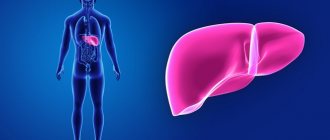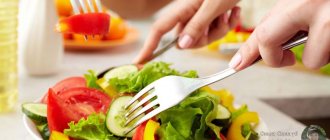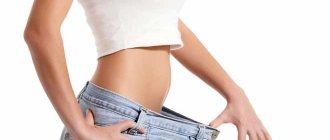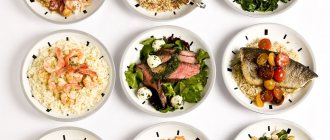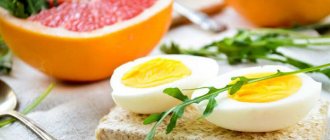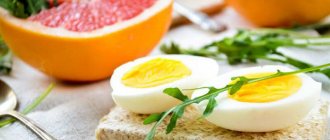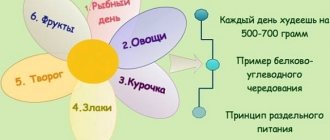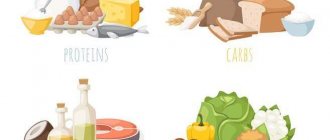Carbohydrates are a source of not only energy, but also fat deposits on the sides. But if you eat the right carbohydrates, you can easily lose those extra pounds. Choose one of 13 carbohydrate weight loss programs and lose weight!
- Reviews from those who have lost weight
Author: Kristina Lobanovskaya, doctor, practicing nutritionist Article updated: 11/10/2020
Ask a Question
Usually, those losing weight are forced to severely limit themselves to foods rich in carbohydrates. Because it is she who is the source of that very excess weight that you so want to get rid of. However, this does not mean that absolutely all carbohydrate foods are absolutely prohibited. This needs to be sorted out. The fact is that carbohydrates are divided into two large groups - simple and complex. The former serve as a source of quick energy - they are easily absorbed and give the body strength. The trouble is that they just as easily settle on the sides, and due to the rapid breakdown of such food, after a couple of hours a person feels hungry again. Complex carbohydrates are not so fast - they break down gradually, making a person feel full for quite a long time. They are considered more useful and preferable. The carbohydrate diet is based on the consumption of predominantly complex saccharides, but some nutritional options also contain simple ones - it depends on the goals you have set for yourself.
General rules
A carbohydrate diet for weight loss is based on a sharp limitation or complete exclusion of simple carbohydrates from the diet and an increase in foods and dishes from them high in complex carbohydrates with a reduced intake of fat. This dietary program, which seems like a paradox to many, is based on accelerating metabolic , which is due to the relatively rapid absorption of carbohydrates in the body.
The importance of carbohydrates in human nutrition is extremely high. First of all, it is the main source of recycled energy that ensures life. The energy function is performed mainly by glucose, fructose, glycogen, sucrose and starch. An important role is played by “indigestible” carbohydrates (hemicellulose, cellulose, pectin), which stimulate the motor function of the gastrointestinal tract, adsorb cholesterol and toxic compounds, and create conditions for the normal functioning of the natural intestinal microflora.
Carbohydrates are represented by a large class of compounds and include both simple - monosaccharides and complex - polysaccharides . The effect of different types of carbohydrates on metabolism varies significantly.
Simple (quickly digestible) carbohydrates - in the body they are broken down into monosaccharides (glucose and fructose), which are quickly absorbed, and if there is an excess of them in the body and there is no immediate need for them, a complex mechanism of their conversion into subcutaneous and intra-abdominal fat is triggered. This type of carbohydrate quickly increases blood sugar levels, which leads to a feeling of fullness, which goes away just as quickly. These include honey, sugar, confectionery, sweet fruits. Such sources of carbohydrates in the diet must be limited.
Complex (slowly digestible) carbohydrates - starch, pectin, glycogen, inulin, fiber. The structure of the molecule is complex and includes dozens of monosaccharides . The process of their breakdown occurs in the small intestine quite slowly (the duration is 2-5 times longer), and the process of their absorption is slowed down by fiber. They slowly increase blood sugar levels and the body is evenly saturated with energy. It is these carbohydrates in food that should be the main source of energy and account for 95% of the daily value. These include various products containing a lot of fiber, pectin, starch (cereals and cereals made from them, white rice, whole grain bread, bananas, pineapple, grapes, dried fruits and others).
A general idea of the carbohydrate content of certain foods can be obtained from the table below.
Table of carbohydrate content in food:
| Product name | Carbohydrate content (per 100 g of product) |
| White bread | 50 |
| Boiled pasta | 25 |
| Cornflakes | 75 |
| Boiled rice | 30 |
| Armenian lavash | 56 |
| Bagels | 58 |
| Bread Borodinsky | 40 |
| Wheat porridge | 26 |
| Buckwheat | 29 |
| White sugar | 105 |
| Marmalade | 70 |
| Honey | 77 |
| Milk chocolate | 60 |
| Walnuts | 12 |
| Peanut | 15 |
| Cashew | 25 |
| Hazelnut | 15 |
| Sunflower seeds | 18 |
| Sesame seeds | 20 |
| Dates | 68 |
| Watermelon | 9 |
| Eggplant | 5 |
| Green peas | 12 |
| Parsley | 8 |
| Tomatoes | 4 |
| Carrot | 5 |
| Sweet pepper | 5 |
| Boiled potatoes | 16 |
| Boiled beets | 7 |
| Fruit kefir | 5 |
| Whole milk | 12 |
| Sour cream | 3 |
| Milk ice cream | 25 |
| Shortbread cookies | 68 |
| Banana | 20 |
| Grape | 15 |
| Raspberries, strawberries | 5 |
| Tangerines, oranges | 7 |
| Apricot compote | 21 |
| Pear compote | 18 |
| Dried rose hips | 22 |
| Red/black currant | 7 |
| Cherry | 12 |
| Apples | 10 |
This list of products will allow you to create your individual dietary menu for the week every day.
The basic principles of dietary nutrition are:
- Follow your individual “norm” of carbohydrate consumption for weight loss, calculated according to the formula: 3.0 g x 1 kg of weight, proteins are not limited, fats are reduced to 75-80 g/day, mainly due to solid animal fats. The total calorie content is about 1600 - 1800 Kcal/day.
- Eliminate or sharply limit foods containing simple carbohydrates from your diet by increasing complex carbohydrates in your menu. The ratio of complex and simple carbohydrates should be approximately 95 to 5 percent.
- Practice split meals.
- The main intake of foods containing complex carbohydrates should be 1 meal in the first half of the day. At other meals it is necessary to combine proteins with carbohydrates. For dinner, it is recommended to avoid eating carbohydrates, giving preference to protein foods.
- Limit salt intake in your diet.
- Avoid snacking between meals, and if this is difficult for you, exclude flour/confectionery products from the snack menu.
- Prepare dishes using dietary methods - steam, boil, bake, stew.
- Drink at least 1.5 liters of free fluid.
Carbohydrates: which ones you can, which ones you can’t
Carbohydrates (sugars) or cargo are special organic compounds necessary for the life of people, animals and plants. In the process of photosynthesis of the latter, the planet receives this important component.
For humans, carbohydrates perform a lot of essential functions. Among the most important are plastic and energy. Being part of more complex molecules, cargos participate in the construction of DNA. But most of all, these compounds are known as the main source of energy for the functioning of the body. Once inside, they oxidize, releasing energy. When 1 gram of carbohydrates breaks down, 4.1 kcal and 0.4 g of water are released.
Content:
- Carbohydrates: which ones you can, which ones you can’t
- The essence of the carbohydrate diet
- Carbohydrate menu
- Calendula decoction for carbohydrate diet
- Mathematical Carbohydrate Diet
- Cream of mushroom soup with celery
- Strict carbohydrate diet
- Advantages and disadvantages
- Carbohydrate diet: what the doctor says
Sugars are made up of special structural units. Depending on the number of these units, they are distinguished: monosaccharides (1 unit), disaccharides (2 units), oligosaccharides and the most complex ones - polysaccharides. It is precisely the latter that are the saviors in the carbohydrate diet.
All simple carbohydrates contain a high glycemic index (sucrose, fructose, glucose, lactose). Once in the stomach, they are quickly digested and converted into sugar. The “cunning” human body is very complex and cannot be easily deceived. In order to prevent hyperglycemia, it simply transforms sugar into fat. This process, from the “point of view” of the human body, is very useful, since stored fat is a guarantee of an energy source for a rainy day. This is the trap for all obese people: with a sharp drop in blood glucose, a feeling of hunger appears. Therefore, when a person eats sweets, he continues to want to eat.
Another thing is complex carbohydrates. These are, first of all, glycogen, starch and cellulose. These components consist of many structural units. Therefore, it takes more time and, most importantly, energy to digest and process them.
Authorized Products
The basis of carbohydrate foods is buckwheat, oatmeal, wheat and rice porridge cooked in water. Be sure to include in your diet all legumes (beans, lentils, peas, chickpeas), whole grain baked goods (whole wheat pasta, whole grain bread). A good source of complex carbohydrates is boiled or baked potatoes.
Do not limit proteins in your diet - eat chicken, rabbit, veal, and low-fat cheese. It is imperative to eat fresh vegetables and fruits rich in fiber: cabbage, zucchini, carrots, eggplants, cucumbers, tomatoes, melons. As for fats, it is recommended to consume refined vegetable oils and, in smaller quantities, butter.
Table of permitted products
| Proteins, g | Fats, g | Carbohydrates, g | Calories, kcal | |
| eggplant | 1,2 | 0,1 | 4,5 | 24 |
| boiled peas | 6,0 | 0,0 | 9,0 | 60 |
| zucchini | 0,6 | 0,3 | 4,6 | 24 |
| cabbage | 1,8 | 0,1 | 4,7 | 27 |
| broccoli | 3,0 | 0,4 | 5,2 | 28 |
| carrot | 1,3 | 0,1 | 6,9 | 32 |
| cucumbers | 0,8 | 0,1 | 2,8 | 15 |
| tomatoes | 0,6 | 0,2 | 4,2 | 20 |
| beans | 7,8 | 0,5 | 21,5 | 123 |
| lentils | 24,0 | 1,5 | 42,7 | 284 |
| buckwheat | 4,5 | 2,3 | 25,0 | 132 |
| oatmeal | 3,2 | 4,1 | 14,2 | 102 |
| millet porridge | 4,7 | 1,1 | 26,1 | 135 |
| white boiled rice | 2,2 | 0,5 | 24,9 | 116 |
| whole grain bread | 10,1 | 2,3 | 57,1 | 295 |
| cottage cheese | 17,2 | 5,0 | 1,8 | 121 |
| veal | 19,7 | 1,2 | 0,0 | 90 |
| rabbit | 21,0 | 8,0 | 0,0 | 156 |
| boiled chicken breast | 29,8 | 1,8 | 0,5 | 137 |
| turkey | 19,2 | 0,7 | 0,0 | 84 |
| * data is per 100 g of product | ||||
Fully or partially limited products
Completely eliminate the consumption of sugar, halva, chocolate, sweets, honey, cookies, jam, dried fruits (raisins, figs, dates, pineapple, etc.), and condensed milk from your diet. You should not eat white bread, gingerbread, rolls, pasta, waffles, crackers, cakes, or semolina from cereals. Fatty meats, lard, bacon, smoked meats, whole milk, cream, fried potatoes, sweet carbonated and alcoholic drinks are excluded.
Table of prohibited products
| Proteins, g | Fats, g | Carbohydrates, g | Calories, kcal | |
Vegetables and greens | ||||
| fried potato | 2,8 | 9,5 | 23,4 | 192 |
Fruits | ||||
| figs | 0,7 | 0,2 | 13,7 | 49 |
Berries | ||||
| grape | 0,6 | 0,2 | 16,8 | 65 |
Nuts and dried fruits | ||||
| raisin | 2,9 | 0,6 | 66,0 | 264 |
| dates | 2,5 | 0,5 | 69,2 | 274 |
Flour and pasta | ||||
| pasta | 10,4 | 1,1 | 69,7 | 337 |
| pancakes | 6,1 | 12,3 | 26,0 | 233 |
Bakery products | ||||
| buns | 7,2 | 6,2 | 51,0 | 317 |
| wheat bread | 8,1 | 1,0 | 48,8 | 242 |
Confectionery | ||||
| jam | 0,3 | 0,2 | 63,0 | 263 |
| jam | 0,3 | 0,1 | 56,0 | 238 |
| candies | 4,3 | 19,8 | 67,5 | 453 |
| cake | 3,8 | 22,6 | 47,0 | 397 |
| jam | 0,4 | 0,2 | 58,6 | 233 |
| halva | 11,6 | 29,7 | 54,0 | 523 |
Cakes | ||||
| cake | 4,4 | 23,4 | 45,2 | 407 |
Chocolate | ||||
| chocolate | 5,4 | 35,3 | 56,5 | 544 |
Raw materials and seasonings | ||||
| mayonnaise | 2,4 | 67,0 | 3,9 | 627 |
| honey | 0,8 | 0,0 | 81,5 | 329 |
| sugar | 0,0 | 0,0 | 99,7 | 398 |
Dairy | ||||
| cream | 2,8 | 20,0 | 3,7 | 205 |
Meat products | ||||
| fatty pork | 11,4 | 49,3 | 0,0 | 489 |
| salo | 2,4 | 89,0 | 0,0 | 797 |
| bacon | 23,0 | 45,0 | 0,0 | 500 |
Sausages | ||||
| smoked sausage | 28,2 | 27,5 | 0,0 | 360 |
Fish and seafood | ||||
| fried fish | 19,5 | 11,7 | 6,2 | 206 |
Alcoholic drinks | ||||
| white dessert wine 16% | 0,5 | 0,0 | 16,0 | 153 |
| vodka | 0,0 | 0,0 | 0,1 | 235 |
| beer | 0,3 | 0,0 | 4,6 | 42 |
| * data is per 100 g of product | ||||
General recommendations for eating on a low-carbohydrate diet
Low-carbohydrate products primarily include oils: coconut, butter or ghee, olive (first-pressed), avocado oil, etc.
While all oils and fats have zero or minimal carbs, not all are healthy. Some oils are processed and contain chemicals. In addition, most vegetable oils contain a lot of Omega-6 fatty acids, which can provoke inflammatory processes if consumed in excess. These fats may also suppress the anti-inflammatory activity of other fats, such as Omega-3s.
For this reason, it is best to avoid oils that are high in Omega-6 fatty acids, namely soybean, corn, canola and peanut oils.
Products recommended for a low-carbohydrate diet
Since the diet will consist mostly of meat, which consists mainly of proteins and fats, make sure that it is of high quality and, ideally, organic, without additives, because their main purpose is to enhance the taste and extend the shelf life of the product. Avoid buying processed meats. Many manufacturers add sugar, spices and flavorings, which increase the amount of carbohydrates.
Although dairy products contain carbohydrates (sugar in the form of lactose), they are often small amounts. You can get protein, calcium, vitamin D and potassium from fermented milk. Milk and yogurt contain the most carbohydrates, but if you are not ready to give them up completely, choose products without added sweeteners or flavors and it is important to watch the number of servings.
Particular attention should be paid to food processing. For a diet, use recipes that involve boiling, stewing, and steaming. Baking is useful. And it is better to completely avoid fried foods.
You also need to choose foods with a low glycemic index (up to 50). They are rich in slow carbohydrates, which take a long time to break down and give you a feeling of fullness. In general, it is worth remembering that people get fat not from carbohydrates, but from an excessively high-calorie diet and a sedentary lifestyle.
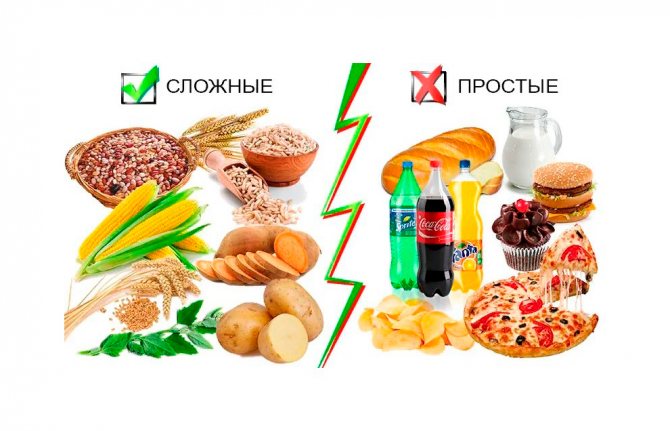
Foods containing simple and complex carbohydrates
Menu (Power Mode)
Here is an example of several menu options.
Option 1
| Breakfast |
|
| Dinner |
|
| Afternoon snack |
|
| Dinner |
|
| For the night |
|
Option 2
| Breakfast |
|
| Dinner |
|
| Afternoon snack |
|
| Dinner |
|
| For the night |
|
Option 3
| Breakfast |
|
| Dinner |
|
| Afternoon snack |
|
| Dinner |
|
| For the night |
|
Advantages and disadvantages
| pros | Minuses |
|
|
Who is not suitable for a low-carb diet?
- Those who suffer from diabetes or have chronic diseases that require close monitoring of blood sugar levels.
- People with problems with the cardiovascular system, blood pressure and gastrointestinal tract.
- Pregnant and lactating.
- Elderly people, teenagers, and those with a low body mass index.
- People with emotional or psychological problems related to food, including eating disorders.
Before trying a no-carb diet, consult with a specialist to make sure it won't harm you.
Adviсe
- For more effective control, keep a special diary. In it you will create your menu with a breakdown of calories and biological value of the diet (amount of proteins/fats/carbohydrates), describe your well-being and psychological state. This is good discipline.
- Don't go on a diet suddenly. It is recommended to prepare the body in advance, which consists of a fasting day (kefir, apple). To improve the cleansing of the body, you should do a full cleansing enema. The same applies to leaving a diet. Expand your diet and increase the volume of portions gradually, over 7 days.
Quitting the diet
The main task when leaving a carbohydrate diet is not to immediately attack prohibited foods. The process of adaptation to the usual menu should be gradual and smooth. Add new foods to your diet every day, delaying the appearance of monosaccharides as long as possible. Believe me, if you manage to extremely reduce the amount of fast carbohydrates in your life and achieve the ideal balance of dietary carbohydrates for you, then problems with excess weight will no longer bother you. When leaving the diet, continue to eat fractionally and in small portions. This will help not stretch your stomach and fill you with small amounts of food.
Comments from nutritionists
In addition to a carbohydrate diet for weight loss, there is a high-carbohydrate diet for weight gain, and many people confuse the principles of nutrition on them. Weight gain is achieved through a combination of high protein and carbohydrate content in the diet (protein-carbohydrate diet), with very limited fat intake. It has its own specifics for carbohydrate intake, both during the day and immediately after training during the open “carbohydrate-protein window”.
For those who find it difficult to tolerate a carbohydrate diet, it is recommended to make snacks and use raw, boiled and stewed vegetables and fruits for this.
During the diet, be sure to take vitamin and mineral complexes.
Popular recipes
An ideal option for a carbohydrate diet would be recipes for vegetable stew with chicken and stewed rice with mushrooms.
Bean and tomato stew with chicken
For the dish you will need the following ingredients:
- 500 g chicken fillet;
- 150 g beans;
- 2 carrots;
- 2 tomatoes;
- 1 onion;
- garlic clove;
- 2 tbsp. l. vegetable oil.
Preparation progress:
- The beans are soaked in cold water for 2 hours, then boiled until tender.
- Chicken fillet is cut into cubes.
- Fry the meat a little in oil and transfer it to a saucepan.
- Add carrot sticks and chopped onions.
- Simmer for 15 minutes.
- Throw in beans, chopped tomatoes, grated garlic.
- Simmer until done.
If desired, you can add dill and bay leaf.
Rice with mushrooms
For preparation you will need the following products:
- 200 g rice;
- 400 g fresh mushrooms;
- 1 onion;
- frying oil;
- spices and herbs to taste.
Recipe:
- The cereal is soaked in cold water.
- Mushrooms are washed and cut into cubes.
- Mix them with chopped onions and fry over a fire.
- Drain the water from the rice and add it to the mushrooms.
- Slowly pour in enough water to hide the grains.
- Reduce heat to low and simmer covered for 20-25 minutes.
- Add spices 2 minutes before the end of cooking.
After the dish is ready, you need to stir it.
Carbohydrate diet: reviews and results
Reviews of the carbohydrate diet for weight loss among those who were on it vary significantly:
- “... The carbohydrate diet turned out to be not effective enough for me - only 3 kg in two weeks. But she helped me balance my diet correctly, since my problem was eating a lot of bread and flour products. I managed to rethink my diet, make it better and healthier”;
- “... I don’t know if you can really lose weight by 5-6 kg in two weeks on a carbohydrate diet or if this is just an advertisement. At least I couldn't achieve this. Although I complied with all the basic requirements”;
- “... I really liked the diet. For me it turned out to be easy. Probably because I have always preferred plant-based foods and even tried to switch to a vegetarian diet. Result: I lost 4.5 kg. I will practice this diet more often, and I recommend it to everyone.”
Advantages and disadvantages
Most diets are aimed at sharply reducing body weight. Many who want to lose weight cannot resist the temptation to get rid of the hated “layers” quickly, easily and for a long time. But, as a rule, such express diets are associated with stress for the body. Excluding the necessary components, minerals and vitamins from the diet has a bad effect on the well-being and condition of the skin and hair. The most aggressive weight loss methods often result in the return of lost pounds.
A carbohydrate diet is accompanied by constant replenishment of the body with the necessary energy. Does not completely exclude proteins, which allows you to maintain muscle tone. At the same time, playing sports is not difficult. Unlike many other modes, fatigue does not appear and loss of strength is not observed. The stomach and intestines remain in order due to the constant supply of food in small portions. The prescribed products contain everything necessary for the proper functioning of the brain and nervous system.
Among the disadvantages, the main one, according to reviews of those losing weight, are fasting days. In the case of a strict carbohydrate diet, it is very difficult to control yourself and not eat something tasty. The first three to four days are a difficult period; the body will rebuild and adapt. But from the fourth, everything will become much easier.
At the end of the second week, some of the lost weight may return. However, if proper nutrition becomes part of life, they will undoubtedly disappear. The main thing to remember is that it is not a diet that is taken as a basis, but proper nutrition. Quitting alcohol, nicotine, sugar and fat has never harmed anyone.
Eliminating sugar from the diet becomes a problem for most people with a sweet tooth. In this case, you should be guided by the rule: “Everything is good in moderation.” An hour's walk in the park will cover one slice of cake. And, if you go for a run, you can sweeten the tea.
